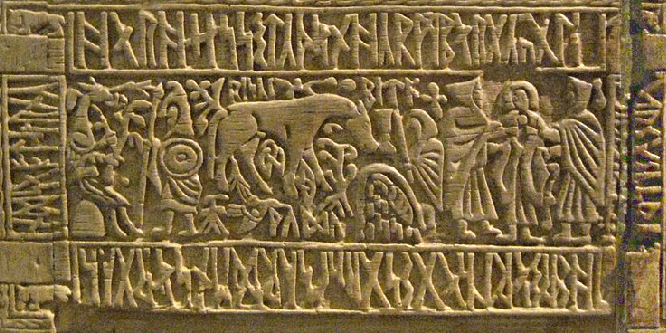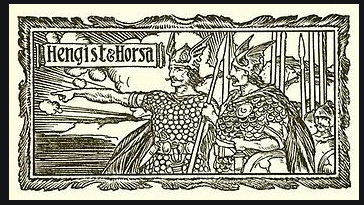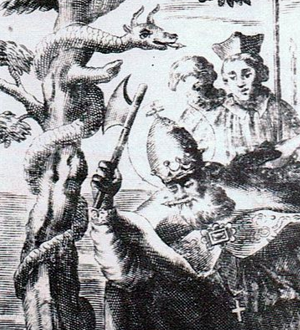3. The weirdest Side of Frank's Casket


Here is my transcription of the Anglo-Saxon runes,
that can be found on the weirdest side of the above casket –
into Odins Runes. This is one of the most depressing and best works
of British art. So do take a close look at this very rare document of
Anglo-Saxon culture, that was written with Anglo-Saxon runes. I would
date it into the time of around 710 b. In that entire era England was
much troubled by the constant raids and invasions of Danish and other
Vikings. So it would not surprise us if the Anglo-Saxon master, who
carved this weird casket, was no good friend of these Nordic bandits
and savages. On the main sides of the casket he carved in scenes that
the Catholics of that era must have liked: Romulus and Remus
travelled far to hell. Then we see the conquest of Jerusalem by the
later emperor Titus. On the front side there is the scene how three
holy kings, or rather Magi, revered Mary and Jesus (instead of False
Smerdis). There are also scenes of Nordic myths on this box. We see
the smith Wayland (Wieland), who was enslaved and crippled but who
took cruel revenge. On top of Frank's casket there is another scene
from Nordic mythology. But what then does the above shown scene on
the right side mean? To further complicate the matter, the carver
only here used some special runes. He tried to be as accurate as
possible when carving in vowels of his language, for whom there
neither existed a Latin letter nor an Anglo-Saxon rune. Here is the
common translation of the above text, the one most widely accepted by
the scholars:
Hēr Hōs siteþ on hearmbeorge: agl?
drīgeþ swā hire Erta gescræf sār-denn
sorge and sefan torne. rixe / wudu / bita
Here Hos sits on the sorrow-mound; She suffers
distress as Ertae had imposed it upon her, a wretched den of sorrows
and of torments of mind. rushes / wood / biter
So this text is about Hos and Ertä, but who
are these? The Wikipedia comment of 01/2021 finds it especially hard
to even describe what the image shows. We only read of animals and
people. And instead of cunning combinations in the style of Sherlock
Holmes now, about an unknown saga of Hos and Ertä maybe, we read
that some scholars try to interpret the scene as that of the mourning
of the Germanic hero Siegfried, by his horse Grani and his daughter
and wife Gudrun! That scene may indeed have inspired the artist. But
then again, the big animal that dominates the scene does not look
much like a horse. It's rather a hound! And what is the other animal
supposed to be, that sits on a mound like a heathen goddess? To me
this looks like an anthropomorphous sow! In fact this idol looks like
a pig goddess revered at a tree. The official description has it that
the armed man in front of the idol is attacking it. Since this is
truly a scene of the mourning of a dead hero, then this warrior must
be Siegfried after death. In his lifetime he probably expected to
meet the Æsir: Wodan, Thor and Tyr. That expectation maybe made
him fight bravely, since the Valkyries allegedly only carry those up
to Asgard who died in battle, or were slain, or at least wounded for
the Nordic gods. But, instead, what he meets in heaven is this pig
goddess! What a nasty surprise! Now here are my transscription and
translation of the inscription, in both Deutsch and English:
Häřh ås sitəþ ån
hərmbäřgə, aglí dřigswá! hiři
értaägis gřáfs ərden sårge and
séft åřnə.
Rísə, wudu bítæ!
Hier Ase sitzt am Harmberge, eklige Drecksau! Ihr
Ehrtage [sie] greift Erden-Sorge und säuft Urin! Reiß,
Wald-Beißer! – Here the Ås sits on harm-mountain,
ugly dirt sow! [On] her honour days [she] grabs earth's sorrow and
sips urine. Tear [her], Wood-Biter!
My translation identifies the idol on the image as
an Ås, one of the Aesir, the Nordic angels. That idea is not
new, and certainly it is much preferable to the idea to read it as a
horse called Hos. But since the few scholars who occupied with such
weird stuff typically had sympathies for Nordic culture and
mythology, they surely often refused to read this text as a vile
intellectual defamation of the Nordic heathen religion. For the same
reason they did not interpret the central animal as a hound, despite
of the fact that the kenning "Wood-Biter" clearly speaks
against it being a horse.
This bitter text makes us think of a Deutsche
artist. He surely had reason to hate the Vikings. When he carved in a
scene of the revenge of Wayland – instead of a planned deluge
scene – that maybe signified that he had become a slave of
these heathens. The artist's intuition made him realize the
weaknesses of the religion of the old Norsemen. Vikings dreamed of an
afterlife in the festive halls of the gods. But in reality such Aesir
didn't exist! Guided by his good sense of inspiration and his
Christian convictions, the artist of this casket sensed correctly
that something was wrong in Asgard. Instead of Nordic gods, pig
demons appeared to welcome dead warriors!
Some artists found out a lot about the secrets of
the Earth Goddess. Indeed she is much in pains and has to carry all
the sorrows of her earth. The Greys mix acid into her
blood.
Eventually the Feken goddesses would help Ewa, to mislead
and scare away enemies.
There's more to see on the carefully designed right
side of Frank's casket. Did you notice the kind of pretzel, right
below the body of the central dog? On Nordic illustrations often such
ornaments occur, of interwoven and crossing lines. Such ornaments
make people think in three dimensions. This sharpens the sense of
visual-spatial imagination and brings the mind nearer to the
inspiration of the good Earth Goddess. The here shown pretzel however
is something special. Such symbols are called valknuts, knots of
destiny. In it's strict form, a valknut resembles a twisted cypher 8.
It's not a coincidence. The eight is a common cosmic symbol for
eternal space. The same symbol ∞ is also used by our
mathematicians to express infinity. But they don't understand the
meaning of this symbol, since their cosmological theories have it
that the universe was created in split-seconds by way of a big bang.
Some Christian wise-crackers then add to this their idea that it was
God who made the big bang bang. At it is typical for nonsense that
the clerics approve, any attempt to teach some better sense to it's
believers would be a waste of time. The truth is off limits for such
types.
The valknut is a Nordic symbol often shown below
Sleipnir, the mare of Odin. It symbolizes the power and magic of the
Nordic gods. But here we see a kind of valknut below this watchdog.
If we take this dog as a symbol for the Greys – of the local
dog stars and others – then the valknut correctly symbolizes
their eternal presence, within the habitable regions of the infinite
universe.
On the right side, of this image of the right side
of Frank's casket, we also see three guys looking like gods, wizards
or monks. These may be interpreted as the three saviour gods of the
old Nordic religion, called Wodan, Hœnir and Loður. The
tales of the Edda have it that these three were the creator gods. The
UTR but teaches that Wodan only used to create poems in his Harz
temple, and that he eventually met other such guys. However, these
three Aesir of the image may be correctly interpreted as symbolizing
the three saviour gods of the local group: Jonathan of Sesam, me from
Gaia and Fred from Lar. And did you notice that there is also the
small image of a hall or cave at the bottom of this image? A woman is
in there aside ornaments resembling many doors. That is of course the
Betyle of the Earth Goddess. Her innermost chamber, the grail, indeed
has millions of gates, who look a bit like the eyebrows of an owl.
Ewa is lucky since the three saviours protect her. Out there in
space, symbolized by the left side of the image, the goddesses of the
Feken live in similar mestabs. But these are not lucky ones, and
saviours couldn't change that any time soon.
The Edda, the Nordic bible, has many tales about
mythical monsters. Few people know that the Vœlospa (talk of
the seeress) also speaks of a hellhound called Garm. He is a
dangerous beast fettered before the field Gnipahellir. When doomsday
comes, Garm allegedly will yell out aloud several times, each time
before a wolf breaks loose. Such a yell means the sounds of celestial
bodies falling down on us. The Bible but has it that seven angels
shall make these sounds with their trumpets. In the ensuing doomsday
battles, the Aesir will allegedly fight against many such monsters to
death. Of Garm the story goes that he and the Ås Tyr will slay
each others. Surely it played a role that Gorm the old, the great
Danish king, had a name that sounded like the name of this dog. He
used to harshly persecute the Christians, since he knew well how bad
they were. But he did not realize that the Earth Goddess had good
reasons to grant victory to the Romans. That was what the Greys
enforced, whose threats to bombard us are still to be taken
seriously.




 When
the two manly Viking chiefs Hengist and Horsa sailed to Britain, they
were not really welcome by most British. But it was the will of God
that they and other Anglo-Saxons should settle there. The objective
was to brighten up the gene-pool, that had been darkened before by
the invasions of the Celtic-Iberians, the Romans and some Irish Picts
and Scots too. These guys from the North of Germania and Europe maybe
had no great culture, but they had classy genes. When the Goddess
looked them in the bright eyes she saw her better future coming, and
foresaw that all would be well on Lar too. Just like the Franks of
that era, they weren't such greedy robbers. Instead of wearing
necklaces they rather wore long shining hair. Some brushed it into
the face, it made them look like angels.
When
the two manly Viking chiefs Hengist and Horsa sailed to Britain, they
were not really welcome by most British. But it was the will of God
that they and other Anglo-Saxons should settle there. The objective
was to brighten up the gene-pool, that had been darkened before by
the invasions of the Celtic-Iberians, the Romans and some Irish Picts
and Scots too. These guys from the North of Germania and Europe maybe
had no great culture, but they had classy genes. When the Goddess
looked them in the bright eyes she saw her better future coming, and
foresaw that all would be well on Lar too. Just like the Franks of
that era, they weren't such greedy robbers. Instead of wearing
necklaces they rather wore long shining hair. Some brushed it into
the face, it made them look like angels. The
great Jacob Grimm found a weird snake story in the acts of Christian
saints (p. 570): Barbatus, a Catholic preacher, let his snake tongue
charm the ears of Theodorada (Theuderada), the wife of king Romuald
of the Lombards in Southern Italy. Those former Germanic Langobards
were still adhering to their traditional heathen culture, but they
tolerated Christians at their court, and not a few had become
baptised. The Catholics however did not tolerate at all any other
religious cultures, except the Jewish. Saint Barbatus envied the
heathens, who revered a snake made of pure gold. So when the king was
on a journey, he asked Theodorada to hand over the snake to him. She
feared that she might die if she did this, but as the priest kept on
conjuring her, she did what he desired. Barbatus then commanded his
minions to fabricate Catholic mass ware from the stolen snake. King
Romuald later didn't punish him.
The
great Jacob Grimm found a weird snake story in the acts of Christian
saints (p. 570): Barbatus, a Catholic preacher, let his snake tongue
charm the ears of Theodorada (Theuderada), the wife of king Romuald
of the Lombards in Southern Italy. Those former Germanic Langobards
were still adhering to their traditional heathen culture, but they
tolerated Christians at their court, and not a few had become
baptised. The Catholics however did not tolerate at all any other
religious cultures, except the Jewish. Saint Barbatus envied the
heathens, who revered a snake made of pure gold. So when the king was
on a journey, he asked Theodorada to hand over the snake to him. She
feared that she might die if she did this, but as the priest kept on
conjuring her, she did what he desired. Barbatus then commanded his
minions to fabricate Catholic mass ware from the stolen snake. King
Romuald later didn't punish him.

 Now
look at this diversity ring! It's maybe worth of serious worries of
our magicians. It looks so bizarre and flashy! It looks like a master
ring of all rings of this world. Should we eventually send out a
hobbit to steal it, and throw it into the gorge of a volcano?
Now
look at this diversity ring! It's maybe worth of serious worries of
our magicians. It looks so bizarre and flashy! It looks like a master
ring of all rings of this world. Should we eventually send out a
hobbit to steal it, and throw it into the gorge of a volcano?